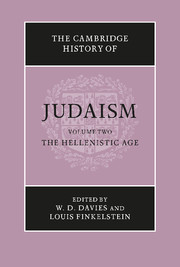Book contents
- Frontmatter
- 1 The archeology of Hellenistic Palestine
- 2 The political and social History of Palestine from Alexander to Antiochus III (333–187 B.C.E.)
- 3 Hebrew, Aramaic and Greek in the Hellenistic age
- 4 The Diaspora in the Hellenistic age
- 5 The interpenetration of Judaism and Hellenism in the pre-Maccabean period
- 6 The men of the Great Synagogue (circa 400–170 .b.c.e.)
- 7 Pharisaic leadership after the Great Synagogue (170 B.C.E.–135 C.E.)
- 8 Antiochus IV
- 9 The Hasmonean revolt and the Hasmonean dynasty
- 10 Jewish literature in Hebrew and Aramaic in the Greek era
- 11 Jewish–Greek literature of the Greek period
- 12 The Apocrypha and Pseudepigrapha of the Hellenistic period
- 13 The book of Daniel
- 14 The matrix of apocalyptic
- 15 The Septuagint and its Hebrew text
- 16 The Targumim
- 17 The Samaritans
- 18 The growth of anti-Judaism or the Greek attitude towards the Jews
- Bibliographies
- Chronological table
- Index
- References
3 - Hebrew, Aramaic and Greek in the Hellenistic age
Published online by Cambridge University Press: 28 March 2008
- Frontmatter
- 1 The archeology of Hellenistic Palestine
- 2 The political and social History of Palestine from Alexander to Antiochus III (333–187 B.C.E.)
- 3 Hebrew, Aramaic and Greek in the Hellenistic age
- 4 The Diaspora in the Hellenistic age
- 5 The interpenetration of Judaism and Hellenism in the pre-Maccabean period
- 6 The men of the Great Synagogue (circa 400–170 .b.c.e.)
- 7 Pharisaic leadership after the Great Synagogue (170 B.C.E.–135 C.E.)
- 8 Antiochus IV
- 9 The Hasmonean revolt and the Hasmonean dynasty
- 10 Jewish literature in Hebrew and Aramaic in the Greek era
- 11 Jewish–Greek literature of the Greek period
- 12 The Apocrypha and Pseudepigrapha of the Hellenistic period
- 13 The book of Daniel
- 14 The matrix of apocalyptic
- 15 The Septuagint and its Hebrew text
- 16 The Targumim
- 17 The Samaritans
- 18 The growth of anti-Judaism or the Greek attitude towards the Jews
- Bibliographies
- Chronological table
- Index
- References
Summary
HEBREW
Apart from final adjustments, the main body of the Hebrew Bible was already complete before Hellenistic times, and it is easy to forget that the latest portions of it were in fact written within that period. Of such portions, however, it is often hard to decide definitely whether their origin was in the Persian or the early Greek period, especially since the setting and subject matter is often Persian, as in Esther and Daniel. Some parts of the prophets, like Zechariah 9 to 14, and more doubtfully other ‘protoapocalyptic’ passages like Isaiah 24 to 27, have been assigned to a Hellenistic date, but even if this is right it may mean the very beginning of that era, a time therefore before its character had yet fully flowered. Some of the biblical psalms may also be Hellenistic; but the dating of psalms is notoriously difficult, and the practice of dating canonical psalms in late (for example, in Maccabean) times is now less widely supported than it once was. Nevertheless it is significant that characteristic ‘late’ linguistic features are displayed by many of the psalms found at the end of the Psalter: for example, the relative še appears only from Ps. 122 on, and then occurs about nineteen times. Since the tradition of psalmody went on and psalms continued to be written after the canonical Psalter was complete, it would not be surprising if some canonical psalms were of Hellenistic date. Finally, one writing which by the main consensus of scholars was written well down within the Hellenistic age is the latest portion of Daniel (8 to 12), coming from the second quarter of the second century b.c.e.
- Type
- Chapter
- Information
- The Cambridge History of Judaism , pp. 79 - 114Publisher: Cambridge University PressPrint publication year: 1990
References
- 2
- Cited by



